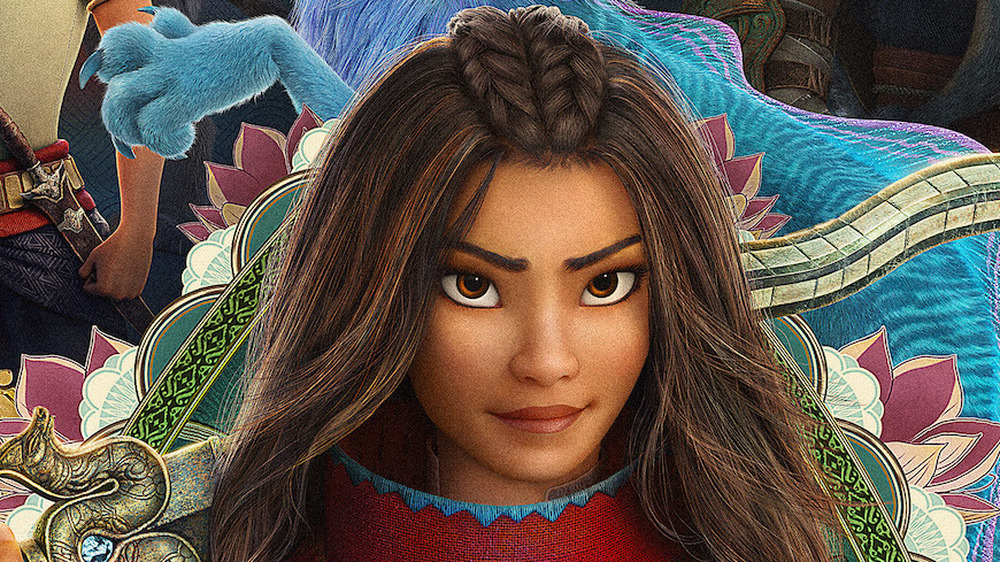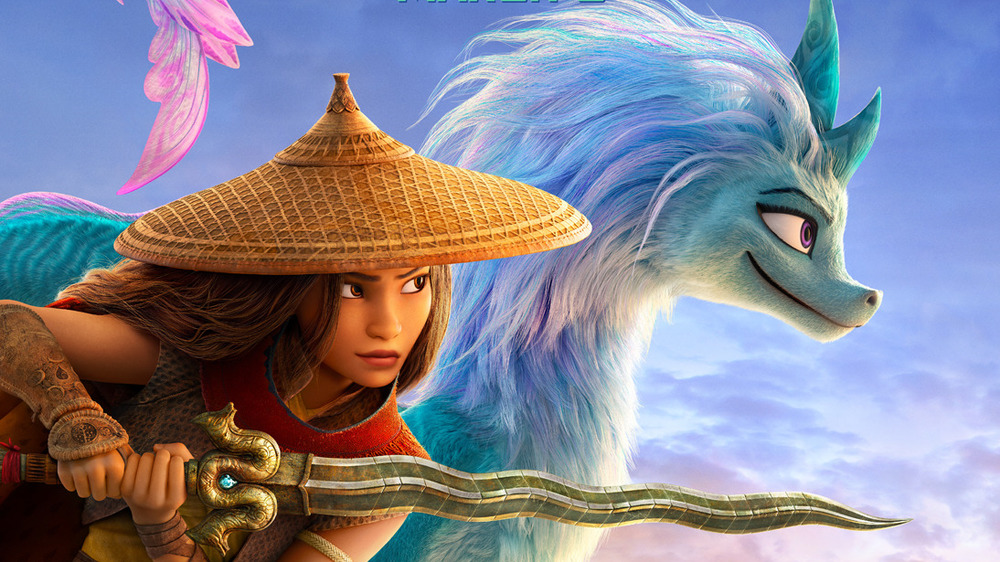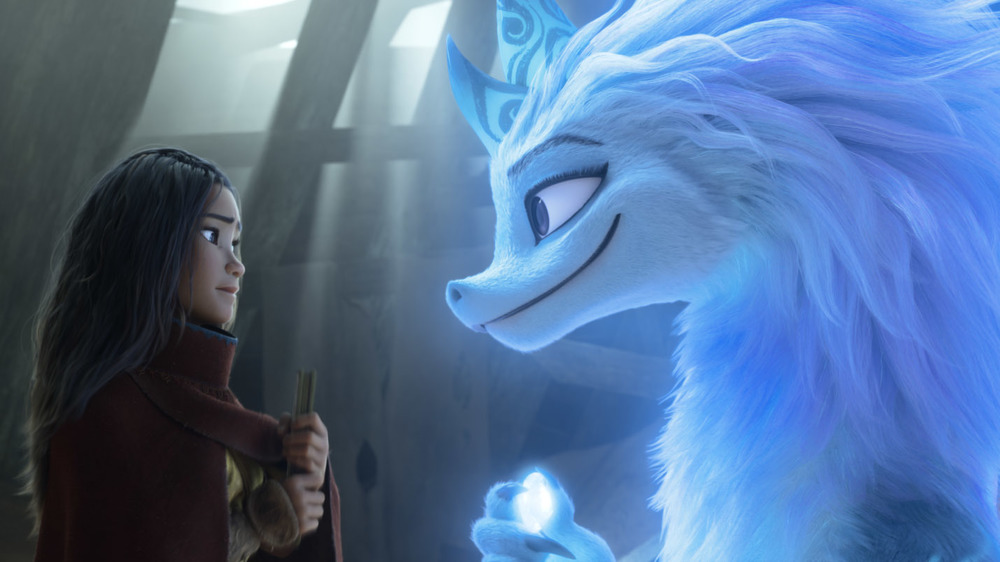Disney Filmmakers Reveal What Really Makes Raya And The Last Dragon So Unique - Exclusive Interview
Raya and the Last Dragon follows warrior princess Raya as she sets out on an epic journey to save her world when an evil plague returns after 500 years of dormancy and turns everyone in her land into stone. The key to reversing the curse is to find the last known dragon that had rescued humanity from the plague once before.
Raya is voiced by Kelly Marie Tran of Star Wars: The Last Jedi and The Rise of Skywalker fame, while Awkwafina portrays the last dragon, named Sisu. Raya and the Last Dragon also stars Daniel Dae Kim as Raya's father Chief Benja, Benedict Wong as the formidable giant Tong, Gemma Chan as Raya's nemesis Namaari, and Sandra Oh as Namaari's mother Chieftess Virana.
In an exclusive interview with Looper, Raya and the Last Dragon directors Don Hall and Carlos Lopez Estrada and writer Qui Nguyen chatted about what Raya stands for in the Disney princess realm and what it was like working with an all-star cast.
Raya is more of a Mad Max-like lone warrior than a typical Disney Princess
Raya is brimming with girl power — there are so many strong female characters — was that angle something you purposely set out to achieve or did it just unfold naturally?
Qui Nguyen: Just to give you a little background on our film, the movie had already been in development for four and a half years before Don, Carlos, and myself came in. We came in about a year and a half ago for the production of the film. And so part of the DNA of it was always Raya and these female warriors doing an epic fantasy set in a world that's based on Southeast Asian cultures.
I think the thing I feel most proud about is the fact that when we went to look for a [comparison] for Raya, it was really difficult to find one in a major motion picture. This epic hero that was also funny and quippy, and all those things. And so, in a lot of ways, we had to build that from scratch on our own, myself and [co-writer] Adele [Lim], and our amazing animation team, which is 450-plus. But it really was crafting a character that we hadn't seen before, on the scale of the size of a Disney animated film. That felt like the thing that was the real challenge in developing this new Disney princess warrior.
What do you hope little girls — and boys — take away from the female-centric storyline?
Carlos Lopez Estrada: I think what we love the most about this story is that even though Raya is a badass female warrior, gender doesn't really play a key role in the story. And I feel like we're so unused to seeing these types of characters that it becomes almost like a highlight, right? People ask us, "What do you think about the fact that...?" And we're like, "Look, she's incredible, but we thought of her as a character who goes on a journey, and who we fall in love with, without having to put gender into the equation."
That's hopefully what people get out of this. It really should not make a difference whether our heroes look a certain way. We'd like for [boys and girls] to think that they can be Raya, that they can be a part of this magical journey, regardless of [gender].
Not to say we're gender agnostic. Let's just say, we thought about Raya as a superhero. We thought about her as an incredibly complex character. And hopefully, people are able to see that, and just be very excited about her.
Don Hall: It would be cool next Halloween to see boys and girls running around with that sword, and that hat, and that cape. Then we would know. It's like, yeah, we crossed over.
The one thing that I would love for kids, or anybody, to pick up on is she is built like a superhero who can kick butt. But ultimately, her greatest strength is her choice to trust someone. That it was an emotional choice at the end of the movie that saved the world. It wasn't her muscles, even though she's built to be a strong character physically, it was something that was much deeper that made her heroic.
Lopez Estrada: And that journey is such a profound journey that really anyone can go on. And if Raya could be that model of what it takes for someone to trust, then I think that would be the most incredible thing.
Equally important to the girl power is Raya is Disney's first Southeast Asian princess. Which previous Disney princesses had the most influence, if any, on her?
Hall: I don't know if any did, to be perfectly honest. None that I can think of. I mean, we didn't really double down on the princess thing. I think we're always imagining that she's technically a princess. Yes, because her father is the chief of Heart. But I think she identifies much more as a warrior, and specifically the guardian of the dragon [crystal]. That's what she's been training her whole life to become, like her father.
And then, during the course of the movie, she actually becomes guardian of the dragon, as well as the gem. So we're always thinking of her as warrior first, princess second. None of the [other] princesses come to mind.
Nguyen: The one that I think most people would probably on the surface go, "Oh, it must be Mulan, right?" Because she's Asian, she fights with a sword. But her journey was so much about her gender. The folklore was about her gender, about her dressing up as a man to fight in the army, to defeat the bad guy.
But that wasn't the center of our story at all. It was more of a Mad Max story of a girl walking through the apocalypse to bring back the world to its old glory. It wasn't something that any of the films that Disney had done previously that we could research on. So it really was having to build that together — we had to trust each other in building this world that we had never seen.
The cast of Raya and the Last Dragon had to record from their homes during the pandemic
Obviously the cast is very impressive — Kelly Marie, Awkwafina, Gemma, Daniel, Sandra — what was it like working with such an all-star cast?
Lopez Estrada: It was a dream. Every recording session with each of them, they brought so much heart and intelligence and humor and creativity to their roles. Really, every recording session we would log out and just be like, "Whoa, that was a profound experience." The cast was so committed. Most importantly, they connected to the story on such a deep level.
There was not one actor who didn't have a strong emotional reaction when we first shared the story — and for different reasons. Some of them had direct cultural ties. Like Daniel Dae Kim, for example, the work that he's been doing here in the States around the Asian American community is very personal. And he's a real voice for that entire community. It really is the work that Benja is doing in the movie.
Sandra Oh, I remember we were talking to her about how Namaari and Virana, her mom, are not really villains. They're just antagonistic forces because they have practical purposes that clash with Raya. They're not villains. And Sandra really opened up about how profound she thought it was that everyone was really just trying to find the best kind of life for their people. So anyway, like that, all of our cast was really, really connected and it made the whole process just really inspiring.
Hall: We should also point out that in addition to being brilliant actors and giving great performances, they had to record themselves. A lot of this was recorded in their closets, and they were asked to be their own engineers and their own technicians and stuff. That's difficult when they're supposed to just be focusing on a performance. But as a testament to each and every one of them and their love of the film, they were able to do it without complaining and just handle it because they love this movie so much.
As for the character Tuk Tuk ... there are so many sidekicks in Disney films. How did you want Tuk Tuk to stand out?
Lopez Estrada: As the best one? [Laughs]
Hall: Obviously, he's sort of the steed, right? He's Raya's steed. But also he's almost kind of a dog-like companion. There's a loyalty to him and a cuddly nature. And I think we were stoked when we added him to the beginning of the movie and you got to see him as just a little guy, thinking that he's not going to get much bigger. And then, seeing him the size of a Volkswagen Beetle.
Lopez Estrada: It's also a really nice emotional tie because he's the only thing that she has left out of her previous life. So, I think, other than being cute and practical for transportation purposes, there's a really nice emotional connection there. We don't see Tuk Tuk when they reunite with Benja. That's a deleted scene...
Hall: He's in the wide shot, the down-shot.
Lopez Estrada: We need that for sure, [Tuk Tuk's] return to Heart.


